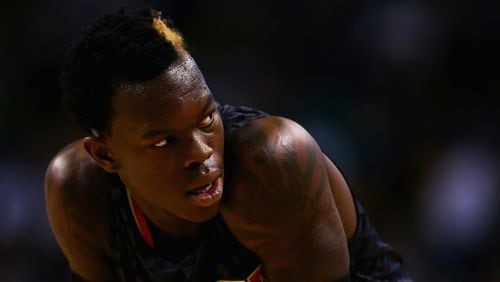Over the next several days I’ll review each Hawks player that was on the roster at the end of the season, in descending order of minutes played.
Previous entry:
Dennis Schroder was the lead player for the Hawks for the first time since the team drafted him in 2013. Schroder played 2,078 minutes in 67 games, and his 30.4 usage rate tied for sixth-highest in the NBA. The six players with equal or higher rates and at least 2,000 minutes played: James Harden, Russell Westbrook, LeBron James, Giannis Antetokounmpo, Damian Lillard and Kevin Durant.
That’s a list of All-Stars, All-NBA guys and future Hall of Famers. Schroder is nowhere near that level and, in my opinion, he’s likely topped out as an average NBA player. I could be wrong — at 24, Schroder is younger than all of those high-usage players except for Antetokounmpo — but his improvements this season were incremental and there were negative trends for him at both ends of the court.
Schroder’s effective field-was below average last season (49.3) and even worse this year (46.9). That decline can’t be explained by a drastic increase in volume for Schroder—he took 19.9 shots per 36 minutes this season compared to 17.6 in 2016-17.
The main issue with Schroder's inefficiency was that he attempted 3-pointers on about 23 percent of his overall shots and made just 29 percent of them. Among the 79 players who played at least 2,000 minutes and had a 3-point attempt rate equal to or higher than Schroder's, his 3-point percentage ranks last.
Last season Schroder shot 34 percent on 3-pointers with a larger volume. It’s true that Schroder drew more defensive attention this season but, per NBA tracking data, Schroder’s 3-point percentage on “wide open” looks declined from 39.3 percent last season (66-for-168) to 30.5 in 2017-18 (43-for-141). Another worrisome sign for Schroder’s 3-point shooting: this season he shot better on pull-ups (29.5 percent on 122 attempts) than on catch-and-shoots (28 percent on 125 tries).
Schroder’s poor 3-point shooting wiped out his efficiency gains in other areas. He earned free throws at a decent rate and made 85 percent of them, but his true shooting percentage slipped to 51.5 from a career-high 53.3 in 2016-17. This season Schroder had a very good turnover percentage (career-best 12.7) and ranked among the best mid-range shooters in the league, but his points per possession barely improved: 0.898 last season, 0.905 this season (per Synergy Sports).
To be more effective offensively without a reliable 3-point shot, Schroder must improve his 2-point efficiency or get to the free-throw line more often. My view is that both will be difficult for Schroder to do for reasons both physical and mental.
Schroder's relatively slight frame makes it difficult for him to finish through contact around the basket. He compensates by contorting his body and using his long wingspan to flip the ball at the rim. Schroder still gets to the basket at a high rate, but his physical limitations mean he probably never will draw fouls at a high rate or finish very efficiently at the rim. According to Cleaning the Glass, Schroder's shooting percentage on attempts at the rim was 55 percent this season and was between 51 and 54 in each of his previous four seasons.
Also, Schroder's over-aggressiveness attacking the rim leads to poor decisions. No NBA player gets his shot blocked more often. Schroder's propensity for so-called "hero ball" leads him to force shots at the basket even when his teammates are open elsewhere. Schroder posted an excellent assist rate this season (36.2) but his assist to usage rate was below-average among point guards (43rd percentile, per CTG).
For the most part, Schroder is a score-first point guard whose value is limited because he hasn’t done it efficiently. That was true when Schroder had a lesser role on better teams, and it remained true when he became the most talented player on a bad one.
And even if Schroder does become more efficient as a high-volume scorer, his well-documented deficiencies on defense would drag down his overall impact. There was a slight uptick in Schroder’s rates of offensive rebounds and steals this season but that’s pretty much where the positives end.
Schroder got better on defense in the latter part of this season, but that mean he improved from perhaps the worst point guard defender in the league to simply bad. Kudos to coach Mike Budenholzer for eventually coaxing better defensive effort from Schroder, and to Schroder for recognizing he had to be better. But if this is as good as Schroder can be on defense, he will have to be a much better on offense to be, at best, better than average overall.
Again, maybe I’m wrong and Schroder can be better. In some ways it feels unfair to judge him so harshly after his first season as the lead Hawks player. He’s still just 24 years old. It’s not as if he’s a bad NBA player.
Then again, Schroder has played 8,341 minutes in the NBA, so this might be all there is for him. Before the season FiveThirtyEight.com's statistical projection predicted that Schroder would be about average this year and stay at that level for a couple of additional seasons before gradually declining. FiveThirtyEight's model got this year right for Schroder and I agree with its future projections, too.
About the Author







